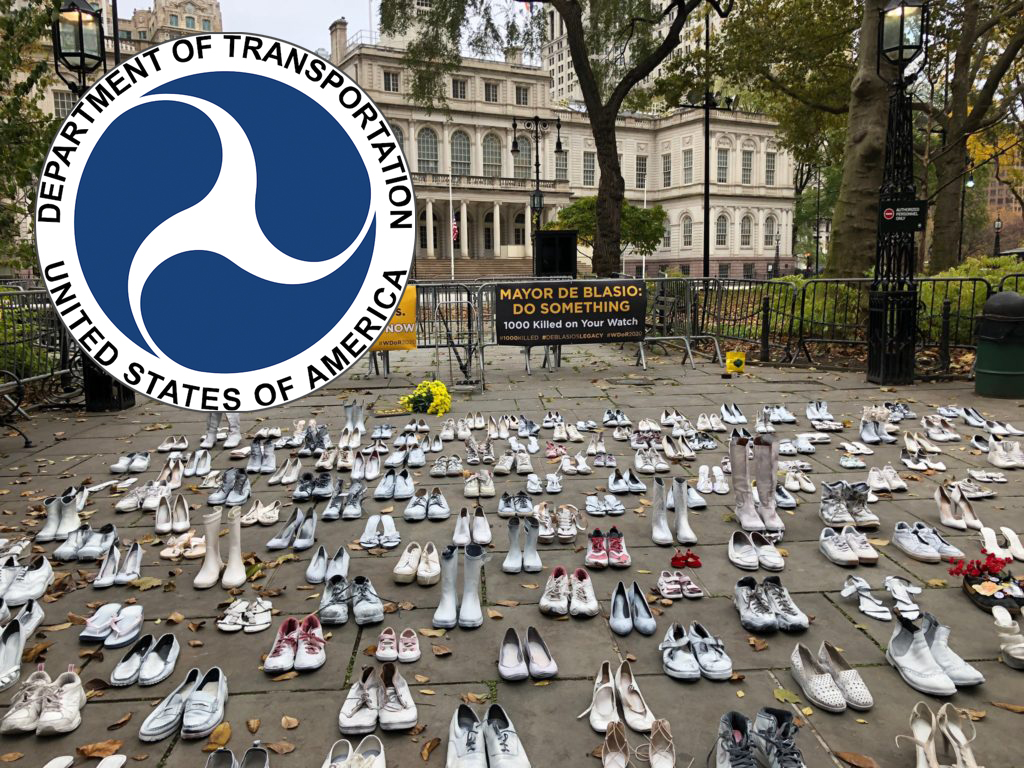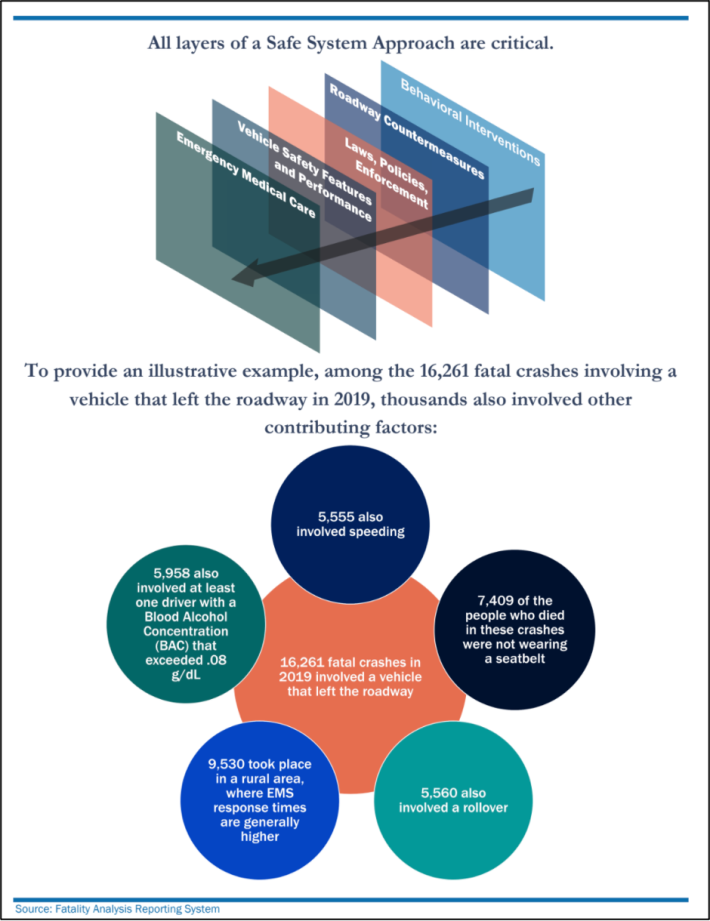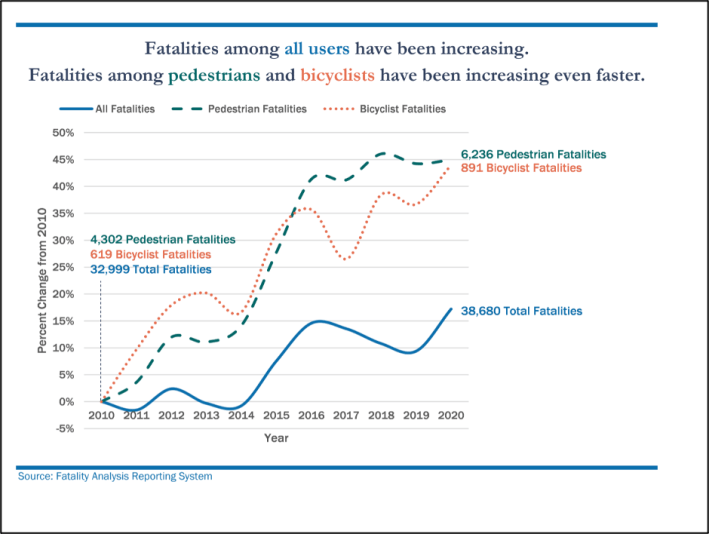Wait a second — did Vision Zero just go national?
For the first time in history, the United States Department of Transportation has committed to using every available resource to end roadway deaths and serious injuries on American roads — fully endorsing the Vision Zero concept embraced by many countries and even some American cities and hoping to get American to get on board.
On Thursday, Secretary Pete Buttigieg revealed the much-anticipated National Roadway Safety Strategy, which outlines the foundational principles the agency will follow to achieve zero road deaths, as well a slate of initial rule-making actions aimed at making every element of the transportation network safer. That strategy is deeply rooted in the "Safe System Approach" which seeks to reverse deadly roadway trends through a focus on "safer people, safer roads, safer vehicles, safer speeds, and post-crash care" — a paradigm shift for which sustainable transportation advocates have fought for decades.
"Americans deserve to travel safely in their communities," Buttigieg said in a statement. "Humans make mistakes, and as good stewards of the transportation system, we should have in place the safeguards to prevent those mistakes from being fatal. Zero is the only acceptable number of deaths and serious injuries on our roadways."
Advocates say both the goal and the method are a sea change for an agency that has long allowed states to set annual safety "targets" that project an increase in traffic deaths from prior years, while simultaneously advising them to design roadways to prioritize driver speed over collective safety, and to "educate" road users simply not to make the deadly mistakes that inevitably follow. Until last week, the National Highway Traffic Safety Administration was still perpetuating the myth that 94 percent of crashes are caused by individual driver error — implying they could not be prevented — rather than a complex range of systemic factors that must be changed.
"We’ve been fighting for years to get the media, the public, and especially transportation agencies to focus on the neglected role of street design in these deaths," said Beth Osborne, director of Transportation for America.
Osborne and her fellow advocates were careful to note, though, that the agency's true level of commitment to Vision Zero won't be confirmed until it begins actually implementing the ambitious plan — and in the context of America's decentralized transportation system, USDOT definitely can't do it alone. The Department cannot, for instance, require state transportation departments to put safety first when those offices begin spending the $110 billion promised to them under the Infrastructure Investment and Jobs Act, though the agency leaders have already said they'll pressure them as much as they can.
Nor can the USDOT compel Congress to pass laws committing them to achieving zero road deaths by any specific date, as most federal lawmakers have so far refused to do.
Roughly a century after the horse escaped, @USDOT considers closing the barn door. https://t.co/DdZTPyOEOC
— Streetsblog New York (@StreetsblogNYC) January 27, 2022
Even more daunting, though, is the task of convincing much of the American people that deadly crashes can end — and that Vision Zero itself is a goal worth urgently pursuing. Traffic violence has been so broadly normalized and deliberately invisibilized for so long that a recent poll showed that nearly 75 percent of Americans didn't even know that 2021 is expected to br the most deadly year on U.S. roadways in 15 years, once federal counts are finalized in the coming months.
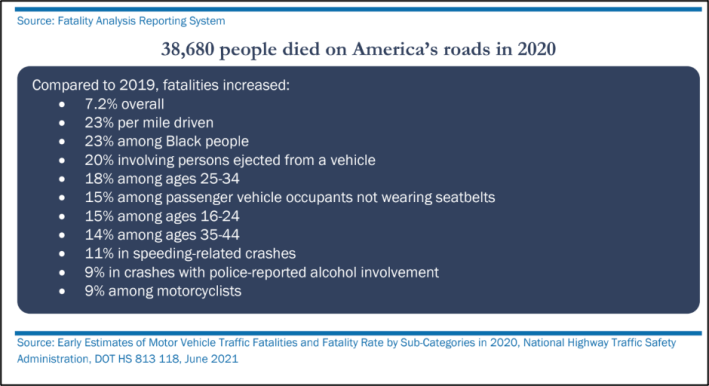
Still, top agency leaders say that by deliberately exposing the true scope of the epidemic — as well as its connections to climate change, and its vast inequities among vulnerable population groups — DOT can get Americans on board, particularly once they realize how traffic violence has already touched their lives, and the lives of everyone they know.
"Today we commit that our goal is this: zero," Buttigieg said on Thursday at the launch event for the new strategy. "I understand the scale of the challenge and the ambition represented by that goal. And I understand that we may not get there during my tenure as Secretary. But the decision — to commit to that goal in a serious way, at a national level — changes the way cities and towns design roads, it changes the ways companies build cars, and it changes the way people drive them."
Here are a few of the highlights of the strategy — and a few things that are missing:
What's in it
A focus on America's safety failures
The first step to solving a problem is admitting you have one. And, boy, does America have a road violence problem.
In the new strategy, US DOT promises to rethink and elevate the now-inscrutably-wonky Transportation Performance Management Dashboard to make it impossible to miss which demographics and communities are being failed by their state's safety approach, and which leaders aren't even trying to reduce the carnage.
The agency also noted, equivocally, which groups have experienced the most alarming traffic violence trends over the last decade: Black and Indigenous people of color, rural road users, pedestrians, cyclists, and teenagers.
“Unfortunately, many roads are not designed to ensure safe travel at safe speeds for everyone, especially the most vulnerable road users,” FHWA Deputy Administrator Stephanie Pollack said in a statement. “The Bipartisan Infrastructure Law provides a tremendous opportunity for FHWA to work closely with State, local and Tribal partners to put increased transportation funding to work incorporating safety for all users into every federally-funded road project.”
DOT will also seek to help cities collect better data on the race and ethnicity of drivers involved in traffic stops, so Americans have more concrete information on who is being disproportionately harassed by law enforcement, and can advocate for more equitable treatment. (More on that later.)
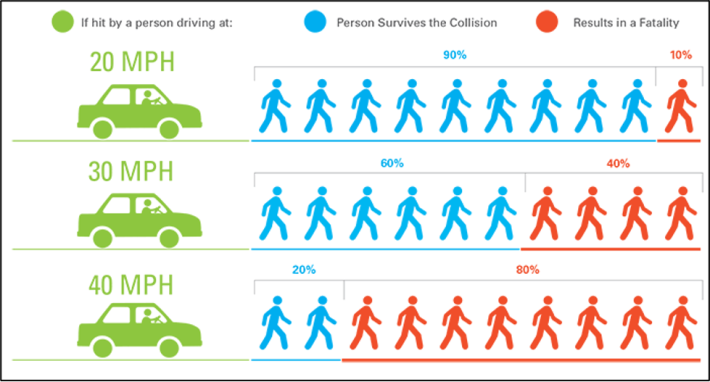
Support for slowing down drivers
Perhaps the most impactful thing transportation leaders can do is use road design and policy to compel drivers to slow down to speeds at which they'd be unlikely to kill themselves or others.
But until now, federal design guidelines like the Manual of Uniform Traffic Control Devices (MUTCD) have advised them to do the opposite, and to set speed limits based on desired vehicle throughput rather than on how likely drivers are to encounter a person walking or rolling on a given road.
The new strategy will "encouraging the setting of context-appropriate speed limits and creating roadways that help to 'self-enforce' speed limits" by revising the MUTCD and other federally-approved manuals — though disappointingly, the agency doesn't expect the biggest changes to happen for a few years. For communities that want to do better than the existing guidelines, though, DOT is launching both a "Complete Streets Initiative" and "a robust, multimodal speed management program" that will connect communities with new resources on how to design roads for vulnerable road user safety first.
Critically, those guidelines will advise against the infamous 85th percentile rule in settings where people walk, bike and roll, and will contain specific advise on street lighting, which experts estimate could cut serious injury crashes by as much as 26 percent.
Action on drunk driving
The Infrastructure Investment and Jobs Act already requires US DOT to explore next-generation drunk driving prevention tech that could stop DUIs before they happen by refusing to let a driver start a car when they have alcohol detectable in their system. And under the new Safety Strategy, the agency will also close a notorious loophole that has allowed motorists convicted of the crime — and other forms of road violence — to obtain licenses in one state after losing them in another.
Under the plan, DOT will "develop systems for the electronic exchange of driver history record information," addressing a problem that's been particularly critical in the interstate trucking industry. It will also seek to de-silo the DOT from public health agencies to better explore the "assessment and treatment of drug and alcohol substance use disorders," which could be a promising start towards addressing the root causes of substance abuse, depending on the specifics.
Better post-crash care
Post-crash care isn't always emphasized prominetnly in a Vision Zero approach, because if the other elements of the Safe System do their job, most road users won't ever need an emergency room.
But the new Safety Strategy hopes to at least help them when they do, through new guidelines and resources aimed at helping high-quality medical care reach crash victims sooner and treat them with more success — particularly problem in rural areas, where "about 39 percent of fatal crash victims do not arrive at a hospital for between one and two hours from the time of the crash, compared to ten percent in urban areas," and who don't always find a bed at a level one trauma center available if they do arrive alive and in time to get the help they need.

What's missing
Action on the SUV arms race
Between the Infrastructure Investment and Jobs Act and the National Safety Strategy, there are some big wins for safe vehicles coming our way, including updates to the New Car Assessment program to emphasize the safety of people outside the car in the event of a crash, a commitment to explore new requirements for automatic emergency braking and pedestrian detection, and new requirements for automakers to report crashes involving automated driving systems.
But advocates pointed out that a few things were missing, particularly when it came to the U.S.' swelling vehicle fleet.
"They’ve failed to specify the impact of the growing size of the front ends of vehicles on the increasing deaths of people outside of them," said Osborne. "Drivers should be able to see the road in front of them for the vehicle to be road worthy."
The strategy also left out any mention of technology that detects and prevent driver distraction, fatigue and disengagement — something that will become increasingly critical the more common advanced driver assistance systems become.
Police abolition
Perhaps the largest oversight in the National Safety Strategy was the complete failure to seriously reckon with the dangers that traffic enforcement itself can pose to road users, particularly to road users of color who are disproportionately the victims of police brutality and murder — or the growing movement to abolish police from traffic safety altogether, particularly when it comes to human officers.
In the document, DOT maintains that "law enforcement and the work of our nation’s law enforcement officers are critical to the prevention and reduction of traffic-related fatalities and injuries," which set alarm bells ringing among some advocates who feared armed enforcement would be advised as a short-term strategy to bring the death toll down when non-violent and design-based means are available.
The department concedes that "traffic enforcement must have equity – the consistent, fair, just, and impartial treatment of all people – at its foundation," but some advocates may have questions about what that will actually look like in practice, and how the training materials the Department plans to develop will actually stop implicit and explicit bias on our roads — if it even can.
Commitment to use all DOT dollars for safety
One of the biggest concerns about the National Roadway Safety Strategy actually isn't in its pages at all — it's in the pages of the Infrastructure Investment and Jobs Act, which will provide roughly ten times as much money for unrestricted highway spending as it does for dedicated safety programs.
That's why some advocates hoped DOT would make a stronger commitment to using its larger discretionary authority to make sure every dollar it does control will be spent on saving lives — something it says the new plan doesn't explicitly do.
"Unfortunately, this plan focuses on using the small safety and bike/ped programs to fund improvements in safety," added Osborne. "USDOT needs to make safety the fundamental consideration of the hundreds of billions that states get in programs such as the Surface Transportation Block Grant Program and the National Highway Performance Program. If safety for our most vulnerable users is the top priority then it will be a priority of all the programs, not just niche programs."
If DOT truly uses the new strategy to make "our existing safety programs more ambitious and more coordinated," as Buttigieg promised in his introductory address, advocates say that will be a good sign that the new plan isn't just lip service — especially if the agency acts quickly on the rest of the agenda as well.
"The key to the success of the NRSS will be swift implementation of identified solutions which have been proven to prevent crashes and save lives," said Cathy Chase, president of the Advocates for Highway and Auto Safety. "The DOT’s commitment to zero fatalities means zero room for hesitation and inaction."
